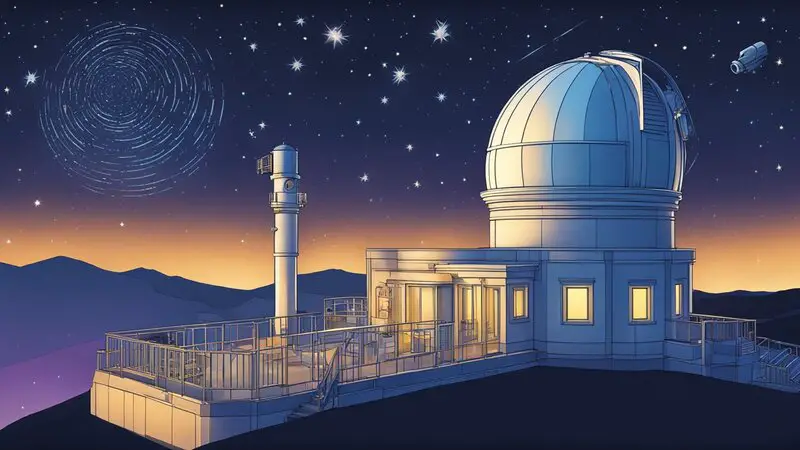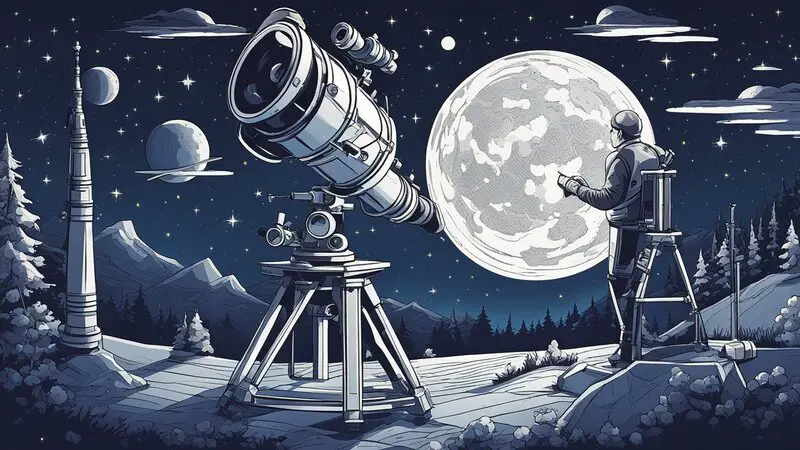You’re on a mission to master the art of stargazing and tap into the universe’s majestic tableau. Astronomical seeing is your gateway, a crucial element that profoundly impacts the clarity and quality of your celestial observations. Understanding this phenomenon is not just beneficial; it’s essential for anyone keen to experience the night sky’s breathtaking beauty in its fullest expression.
However, the journey isn’t without its obstacles. Atmospheric turbulence is a formidable barrier, distorting the celestial images you crave to witness in pristine detail. This distortion can cloud your experience, making the stars and planets seem frustratingly elusive and out of reach.
Fear not, for in this guide, I provide you with a roadmap to navigate these challenges with confidence and expertise. I offer actionable strategies and insights that empower you to mitigate the effects of turbulence and optimize your observational experiences, ensuring each stargazing session resonates with clarity and wonder. Armed with this knowledge, you’re poised to transform your astronomical observations into moments of unmatched celestial brilliance.
Let’s dive right in.
Understanding the Concept of Astronomical Seeing

What is Astronomical Seeing?
Through countless nights observing the heavens, I’ve experienced firsthand how astronomical seeing phenomenally affects one’s celestial viewing, altering the appearance of stars and planets.
Observing outer space through my telescope, I have noticed that the image quality profoundly depends on the seeing conditions at my specific location. Good seeing means steadier images, while bad seeing can make it hard to observe fine details.
Atmospheric turbulence is the primary cause of poor seeing, as it bends and distorts the light from celestial bodies. Thermal convection and winds create turbulent areas with different optical refraction indexes, which alters the incoming light wavefronts.
7 Tips for Astronomical Seeing
In the following sections, I’ll go into more detail about each of these 7 tips about Astronomical Seeing:
| Tip Number | Tips for Optimal Astronomical Seeing | Brief Explanation |
|---|---|---|
| 1 | Choose the Right Location | Opt for high-altitude locations far from city lights and pollution to reduce atmospheric interference. |
| 2 | Understand and Monitor Weather Patterns | Opt for stargazing during calm, cool nights with low humidity to reduce the effects of thermal convection. |
| 3 | Choose the Right Telescope | Select telescopes with lower magnification and shorter focal lengths to reduce atmospheric distortion. |
| 4 | Utilize Adaptive Optics Technology | Implement adaptive optics to dynamically compensate for atmospheric disturbances. |
| 5 | Time Your Observations | Plan around moon phases, meteor showers, and weather patterns for clearer skies and optimal viewing. |
| 6 | Monitor and Adapt to Changing Atmospheric Conditions | Stay flexible and adapt your stargazing sessions based on unexpected changes in weather and seeing conditions. |
| 7 | Utilize Forecasting Tools and Resources | Use resources like Clear Sky Chart for accurate forecasts and planning your observational sessions. |
How Atmospheric Turbulence Affects Starlight
When starlight travels through Earth’s atmosphere, it encounters layers of air with varying temperatures and densities. These layers cause the light to bend in different directions, creating a “twinkling” effect.
Temperature gradients in the atmosphere contribute significantly to this twinkling effect observed in stars. However, this twinkling is a sign of poor seeing conditions. In ideal observing conditions, stars would appear as steady points of light. This effect can be even more pronounced when observing double stars.
In my experience, altitude, weather, and location have significantly impacted the quality of astronomical seeing during my observations.
- Altitude: At higher altitudes, there’s less atmosphere between you and the stars, meaning less chance for turbulence and distortion.
- Weather: Calm, cool nights with low humidity can lead to better seeing conditions as there’s less thermal convection.
- Location: Observing from a place far from city lights and pollution can improve your viewing experience. Light pollution can worsen seeing by adding glare to the atmosphere.
By incorporating an understanding of these factors in my planning, I have optimized my stargazing sessions, targeting times when the skies are at their clearest and steadiest.
Astronomical Seeing and Its Influencing Factors
| Factor | Description | Impact on Seeing |
|---|---|---|
| Altitude | Higher altitudes have less atmosphere, reducing turbulence. | Improves clarity and reduces distortion |
| Weather | Includes temperature, humidity, and wind speed. | Varies, calm and cool weather is ideal |
| Location | Proximity to urban areas and geographical position. | Light pollution affects visibility |
FREE STARGAZING CHECKLIST
My 5-page Stargazing Checklist will enhance your astronomical observations.
Follow this free checklist to navigate the night sky with confidence, clarity, and a sense of preparedness for a rewarding stargazing experience.

The Science Behind the Blur: Atmospheric Turbulence Theory

Basic Atmospheric Turbulence Theory
Atmospheric optical turbulence is the reason why stars sometimes twinkle. It’s caused by different layers of Earth’s atmosphere having different temperatures, pressures, and wind speeds.
These atmospheric differences lead to variations in the refractive index, affecting astronomical objects’ light path causing a blurring effect known as astronomical seeing. Diffraction also plays a role in blurring the images of celestial objects observed through a telescope.
Due to the palpable atmospheric distortions, I often feel like I’m looking at stars through a swimming pool. As the water moves and ripples, the star’s light appears to shimmer and distort. That’s similar to what happens in our atmosphere.
Common Atmospheric Paths and Their Influence
Different atmospheric paths have different turbulence levels, which can influence the clarity of your view.
For example:
- Near the ground: The air closest to Earth’s surface is often turbulent due to heat, causing refractive index variations. This results in the most distortion, making observing stars low on the horizon harder. Other atmospheric paths, such as those at higher altitudes, might offer clearer views due to reduced turbulence.
- Mid-altitude: As you move higher, the wind becomes more stable, which decreases turbulence. The seeing improves in this zone, making it an excellent spot for amateur astronomers.
- High altitude: At very high altitudes, wind can become turbulent again due to the jet stream, making it challenging to observe stars without specialized equipment.
Remember to take note of your location’s atmospheric conditions, as they can heavily influence the visibility of celestial objects.
Atmospheric Turbulence by Altitude Levels
| Altitude Level | Description | Turbulence Level |
|---|---|---|
| Near Ground | Turbulence due to heat and buildings. | High |
| Mid-altitude | More stable winds, less direct heat sources. | Medium |
| High Altitude | Affected by jet streams and cooler temperatures. | Variable |
Deciphering the Simplified Atmospheric Turbulence Structure
Now that you understand the basics of atmospheric turbulence, here’s a simplified explanation of its structure:
- Layer thickness: Turbulence layers vary in thickness, affecting the degree of blurring. Observing in the infrared spectrum can sometimes help in minimizing the effects of atmospheric turbulence.
- Fried parameter: This value indicates the strength of atmospheric turbulence at a given location. A higher Fried parameter means better seeing conditions.
- Air Mass: The amount of atmosphere a beam of light must travel through to reach you. Higher air mass means more opportunity for turbulence impact.
So, when planning your next stargazing adventure, remember these concepts to maximize your viewing experience. Remember that patience and timing are essential for astronomical seeing—because, after all, the sky is the limit!
How Seeing Affects Your Observations and Photography

The Role of Seeing in Telescope Observations
In my nights spent observing the sky, it’s become evident that the clarity of the view hinges predominantly on the quality of astronomical seeing. One of the factors affecting this clarity is the diffraction limit of the telescope being used for observations.
Atmospheric seeing refers to the blurring and distortion of celestial objects caused by Earth’s atmosphere. For example, when you look at stars, planets, or the Moon through a telescope, the seeing conditions can affect the image’s sharpness.
The diameter of the telescope’s aperture often determines the level of detail and sharpness in the observed celestial objects.
Imagine stargazing on a night when Mars, Jupiter, and the Moon are aligned. If the seeing is excellent, you’ll enjoy sharp, detailed views of the celestial objects.
You’ll see Mars’ reddish hue, Jupiter’s swirling storms, and the Moon’s impact craters. However, if the seeing is poor, your view will be blurry, and you might miss out on these fascinating details.
Location Characteristics
| Location Aspect | Effect on Astronomical Seeing |
|---|---|
| City Proximity | Increased light pollution, decreased visibility. |
| Geographical Height | Higher locations face less atmospheric distortion. |
Having tried various locations, I’ve found that it’s better to go outside city limits with less light pollution, markedly enhancing the quality of my telescope observations.
Throughout the night, pay attention to how the seeing conditions change. When conditions are good, try viewing the more delicate targets in the night sky, like Jupiter or Mars.
Seeing Impact on Astrophotography and Auto-guiding
If you’re into astrophotography, seeing plays an even more significant role. Poor seeing may result in blurry or distorted star shapes in long-exposure night sky images. The exposure time needs to be meticulously managed to minimize the distortions caused by the Earth’s atmosphere during astrophotography sessions.
To compensate for this, you can use auto-guiding, which keeps your telescope tracking a target accurately during the exposure.
Using auto-guiding can help to:
- Reduce distortion in long-exposure images
- Increase angular resolution
- Improve image sharpness
However, even with auto-guiding, the seeing conditions will still affect the final quality of your images.
So, to create stunning astrophotos, look for nights with good seeing and be patient. You’ll soon capture breathtaking night sky photos showcasing the universe’s wonders.
Mitigating the Effects of Poor Seeing

Choosing the Right Telescope for Different Seeing Conditions
When battling less-than-perfect seeing conditions, picking the right telescope is crucial.
Here are a few tips to help you choose:
- Low magnification: Telescopes with lower magnification tend to cope better under poor seeing conditions, as the smaller details are less affected by atmospheric disturbance. The size of the telescope’s aperture also plays a significant role in determining the quality of the images observed.
- Shorter focal length: Opting for a telescope with a shorter focal length or using a camera sensor with larger pixels can help with imaging sharpness, as the structure of the image is less affected by the atmosphere.
Telescope Choices
| Telescope Feature | Ideal Condition | Description |
|---|---|---|
| Low Magnification | Poor Seeing | Reduces impact of atmospheric distortion. |
| Shorter Focal Length | Varied Seeing | More forgiving in various seeing conditions. |
Practical Tips for Improved Observations in Varied Seeing Conditions
Now, let’s talk about practical ways you can enhance your observations despite tricky seeing conditions. However, remember that even with the best strategies, the clarity of celestial observations is limited by atmospheric conditions.
- Choose your location wisely: High-altitude observatories like Mauna Kea have a clear advantage over their low-altitude counterparts. The thinner atmosphere creates less interference with astronomy observations.
- Timing is everything: Poor seeing often occurs after cold fronts have passed, as cooler air mixes with warmer, causing local convection. Pay close attention to weather patterns before setting up your telescope for the night.
- Watch the clouds: Scattered clouds can wreak havoc on your stargazing plans. Keep an eye on the cloud cover and plan your observations around periods of clearer skies.
- Adaptive optics: While not accessible to everyone due to cost, investing in adaptive optics technology can help mitigate the effects of poor seeing, as they dynamically compensate for atmospheric disturbances.
Tips for Improved Observations
| Tip Type | Description |
|---|---|
| Location Choice | High-altitude locations with low light pollution are ideal. |
| Timing | Observe when the weather is calm and clear. |
| Adaptive Optics | Use adaptive optics to dynamically adjust to atmospheric changes. |
By following these tips and choosing one of the top amateur telescopes, you can make the most of your astronomical adventures, no matter the obstacles the atmosphere may throw at you.
Forecasting and Planning for Optimal Viewing

Tools and Techniques for Predicting Good Seeing
To make the most out of your stargazing sessions, it’s essential to have an idea of the upcoming seeing conditions. Several resources help you predict good seeing and plan your observations.
Websites like Clear Sky Chart gather data from weather organizations around the world and are typically used to provide forecasts for stargazers worldwide.
These tools consider factors such as:
- Atmospheric seeing: The steadiness of the atmosphere directly affects the clarity of your target astronomical object.
- Transparency: How transparent the sky is, affected by factors like clouds and atmospheric pollutants.
- Light pollution: The night sky’s brightness from artificial light sources can wash out dimmer objects.
When to Observe: Timing Your Sessions for Clarity
The quality of a night’s viewing depends a lot on timing.
Here are a few tips to pick the best times for optimal observing conditions:
- Sunrise and sunset: Observing during twilight or just after sunset can offer incredible views of the night sky without interfering with the sun’s light.
- Moon phases: Plan your observation sessions around the Moon’s cycle. For example, a new Moon provides the darkest skies for observing faint objects like galaxies and nebulae. At the same time, a full Moon can be perfect for observing lunar craters.
- Meteor showers: Check the schedule of upcoming meteor showers, and plan your observing sessions around their peaks for a chance to see spectacular “shooting stars.”
Despite meticulous planning, I’ve found that Mother Nature invariably has the final say, often bringing unexpected conditions. So, stay flexible and adjust your stargazing sessions accordingly.
Frequently Asked Questions
How does atmospheric turbulence affect astronomical seeing?
Atmospheric turbulence primarily distorts astronomical seeing by causing the light from celestial bodies to bend and blur. Variances in temperature, pressure, and wind speed in Earth’s atmosphere lead to this turbulence, causing the stars and planets to twinkle or appear unsteady. These variances are directly related to the quality of astronomical seeing that one experiences.
What practical strategies can improve observation in varied seeing conditions?
Improving observation in varied seeing conditions involves:
- Choosing a high-altitude location.
- Being mindful of weather patterns.
- Utilizing adaptive optics technology when possible.
These strategies help mitigate atmospheric disturbances, enhancing the clarity of celestial objects during your stargazing sessions.
How can one optimize the timing of stargazing sessions for better astronomical seeing?
Optimizing the timing of stargazing sessions requires planning around weather patterns, moon phases, and meteor showers. By aligning your observations with favorable atmospheric and celestial conditions, you can enhance the clarity and quality of your astronomical viewing experience. Understanding astronomy seeing is fundamental to optimizing the stargazing experience.
Summary: Astronomical Seeing
Thank you for reading my article about astronomical seeing.
In this guide, I’ve provided you, the amateur astronomer, with essential knowledge and strategies to navigate the challenges posed by atmospheric seeing. Understanding the impact of atmospheric turbulence is crucial. Metrics such as the full width at half maximum (FWHM) are used to quantify the blurring and twinkling effects caused by atmospheric turbulence in astronomical observations. It’s not merely a static barrier but a variable one, influenced by changing weather, location, and altitude.
You can optimize your stargazing experiences by applying practical strategies. Prioritize high-altitude locations, be mindful of weather patterns, and consider technological aids like adaptive optics. These actions are pivotal in mitigating the effects of poor seeing, allowing you to observe celestial objects with enhanced clarity and precision.
Remember, successful stargazing is a product of both preparation and adaptability. Armed with the right tools and knowledge, you’re well-positioned to make the most of each astronomical observation, transforming challenges into opportunities for remarkable celestial exploration.
Happy Stargazing!
Continue your journey with my series on The Night Sky:




